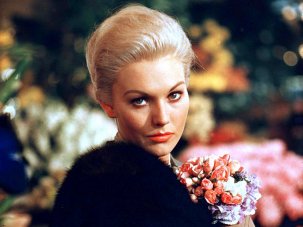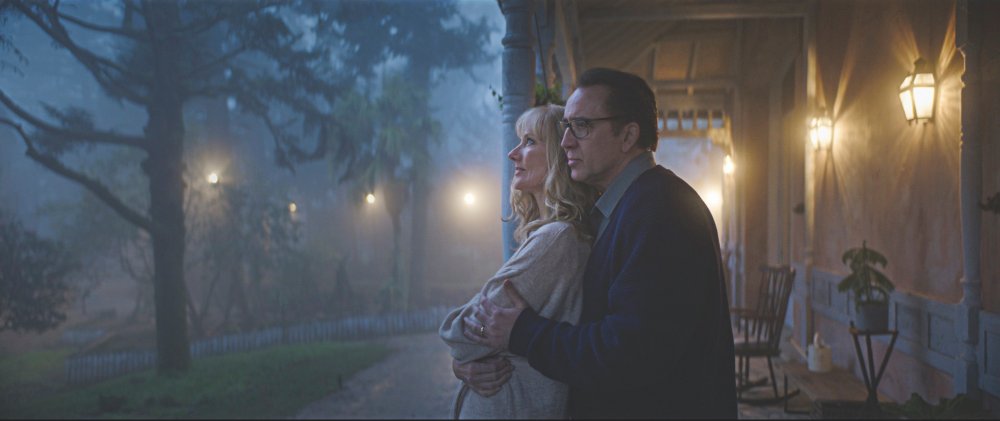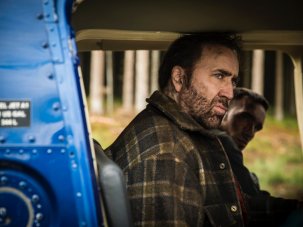The American author H.P. Lovecraft wrote intense, peculiar, visionary cosmic horror stories, mostly for pulp magazines – The Colour Out of Space first appeared in Amazing Stories in 1927 – but edged closer to mainstream consciousness after his death in 1937, thanks to the work of a circle of devotees who kept him in print. He experienced a paperback revival in the 1960s and 1970s, when his paranoid concerns, fuelled in his case by neurotic xenophobia, chimed with countercultural psychedelia.
USA/Portugal/Malaysia 2019
Certificate 15 108mins
Director Richard Stanley
Cast
Nathan Gardner Nicolas Cage
Theresa Gardner Joely Richardson
Lavinia Gardner Madeleine Arthur
Benny Gardner Brendan Meyer
[2.35:1]
UK release date 28 February 2020
Distributor Studiocanal
studiocanalslate.co.uk
► Trailer
The South African director Richard Stanley made a start on a mainstream genre career with the cyberpunk horror film Hardware (1990) and the African mystic serial-killer movie Dust Devil (1992), then was ousted from The Island of Dr Moreau (1996) in circumstances explored (and mythologised) in the documentary Lost Soul: The Doomed Journey of Richard Stanley’s Island of Dr Moreau (2014).
For his long-in-coming third completed feature, Stanley and co-writer Scarlett Amaris adapt the story Lovecraft considered his favourite among his fictions. The conflicting impulses of pulp commercial genre and transcendental terror thrum through the oeuvres of many outsider artists, and Stanley is far from the first to turn to Lovecraft as a high priest of this twisting pathway. Add the very wayward Nicolas Cage to the mix – raising the question of whether you get the fully engaged Cage of Mom and Dad (2017) or Mandy (2018) or the walk-through-and-cash-the-cheque Cage of a dozen other recent projects – and Color Out of Space is a tantalising prospect indeed.
One surprise, perhaps, is that the result is almost low-key in its accumulation of dread, working steadily towards a mini-apocalypse for one nuclear family rather than our entire plane of existence. Cage presents as eccentric, of course, playing struggling farmer Nathan Gardner, whose ordinary woes – a wife not yet fully recovered from cancer, a risky venture with alpacas, three variously awkward children – metastasise thanks to the mutagenic influence of a chunk of alien rock that crashes into his front yard and poisons the well. We glimpse a character reading one of Lovecraft’s inspirations – Algernon Blackwood’s The Willows – and this Portuguese-shot version of Lovecraft’s haunted New England wood is appropriately populated by half-glimpsed things and unexplained rustlings well before the explicit horrors show up.
The Colour Out of Space (the author preferred the British spelling) is stripped-down Lovecraft, relatively free of the trappings of his invented mythology – used by so many to yoke their own work to his – though Stanley does allow a glimpse of the Necronomicon, Lovecraft’s tome of evil. It is also the most frequently adapted of his stories, perhaps because it offers a relatively straightforward narrative with something like proper character development, as opposed to the elliptical, collage-like structure of The Call of Cthulhu or The Shadow Out of Time. Daniel Haller’s Die, Monster, Die! (1966), Pascal Kané’s La Couleur de l’abîme (1982), David Keith’s The Curse (1987), Ivan Zuccon’s Colour from the Dark (2008) and Huan Vu’s Die Farbe (2010) have all trudged out to the Gardner farm and observed the effects of that malign meteorite; all have grappled with one of Lovecraft’s least filmable ideas – an imaginary colour (“It was only by analogy that they called it colour at all”).
In Stanley’s vision, this becomes a purplish-pink neon reminiscent of certain lighting choices made by Dario Argento (Suspiria, Inferno), George A. Romero (Creepshow – which includes a Stephen King story that’s a gloss on the Lovecraft), Stuart Gordon (From Beyond, 1986) and Ted Nicolaou (TerrorVision, 1986). A commingling of 1980s VHS and 1960s lava-lamp aesthetic is overlaid on Lovecraft’s out-of-time vision, even with mutterings about iffy wi-fi in the woods, suggesting Stanley is picking up exactly where his filmography was interrupted by the wilderness adventure with Dr Moreau that left him stranded in a jungle, turned into one of his own beast-men.
Lovecraft was never afraid of seeming absurd, and elements here indulge Cage’s propensity for uncontrolled genre camp (most notably expressed in 1988’s Vampire’s Kiss). The actor’s every utterance about or involvement with alpacas is hysterical, climaxing in an unholy fusion of animals into a living, multi-limbed carpet creature; and one perfectly turned demented line (“Benny lives in the well now”) bids to become as quoted and sampled as his bee rants from the 2006 remake of The Wicker Man.
However, everyone else takes things slower and stranger, with wife Theresa (Joely Richardson) so brittlely resentful of her family’s deleterious effect on her health and business that she attempts to reabsorb one of her children into her body. Amid the rampant mutation of plant and animal life, Madeleine Arthur and Brendan Meyer are remarkably subtle as the older Gardner children, numbly taking the blame for mishaps that are the result of vast cosmic forces converging on their home, doing their best to cope even as the poisoned well-water makes them glow from the inside.
-
The 100 Greatest Films of All Time 2012

In our biggest ever film critics’ poll, the list of best movies ever made has a new top film, ending the 50-year reign of Citizen Kane.
Wednesday 1 August 2012
-
The best films now on UK streaming services

Looking for the best new cinema releases available on British VOD platforms? Here’s our guide to how to keep up with the latest movies while you’re...
-
The Digital Edition and Archive quick link
Log in here to your digital edition and archive subscription, take a look at the packages on offer and buy a subscription.






